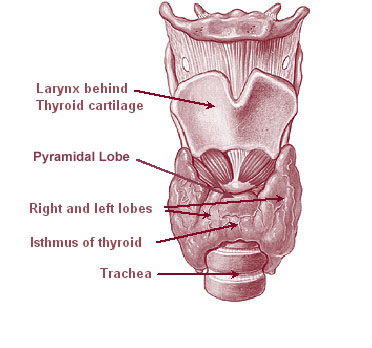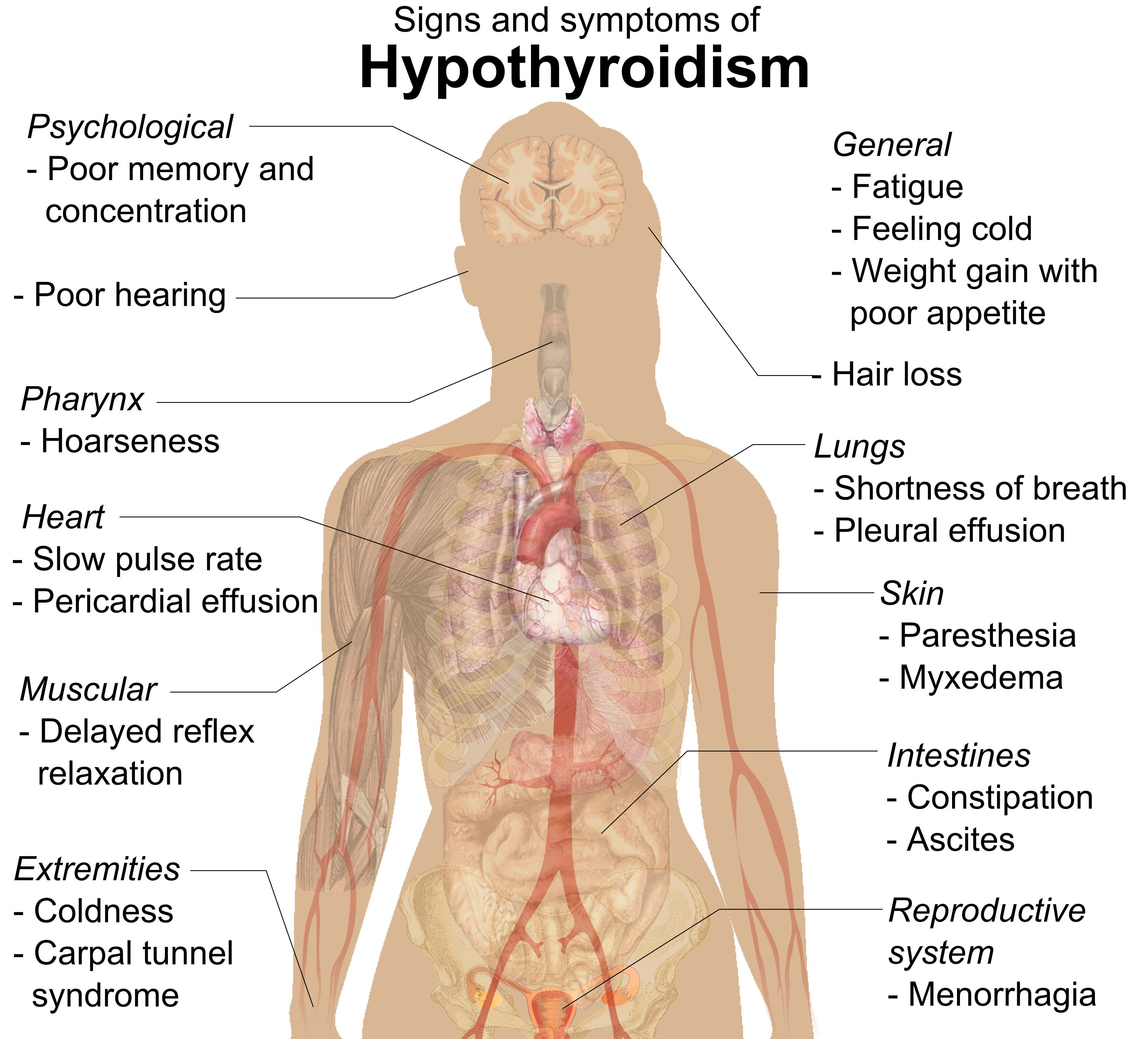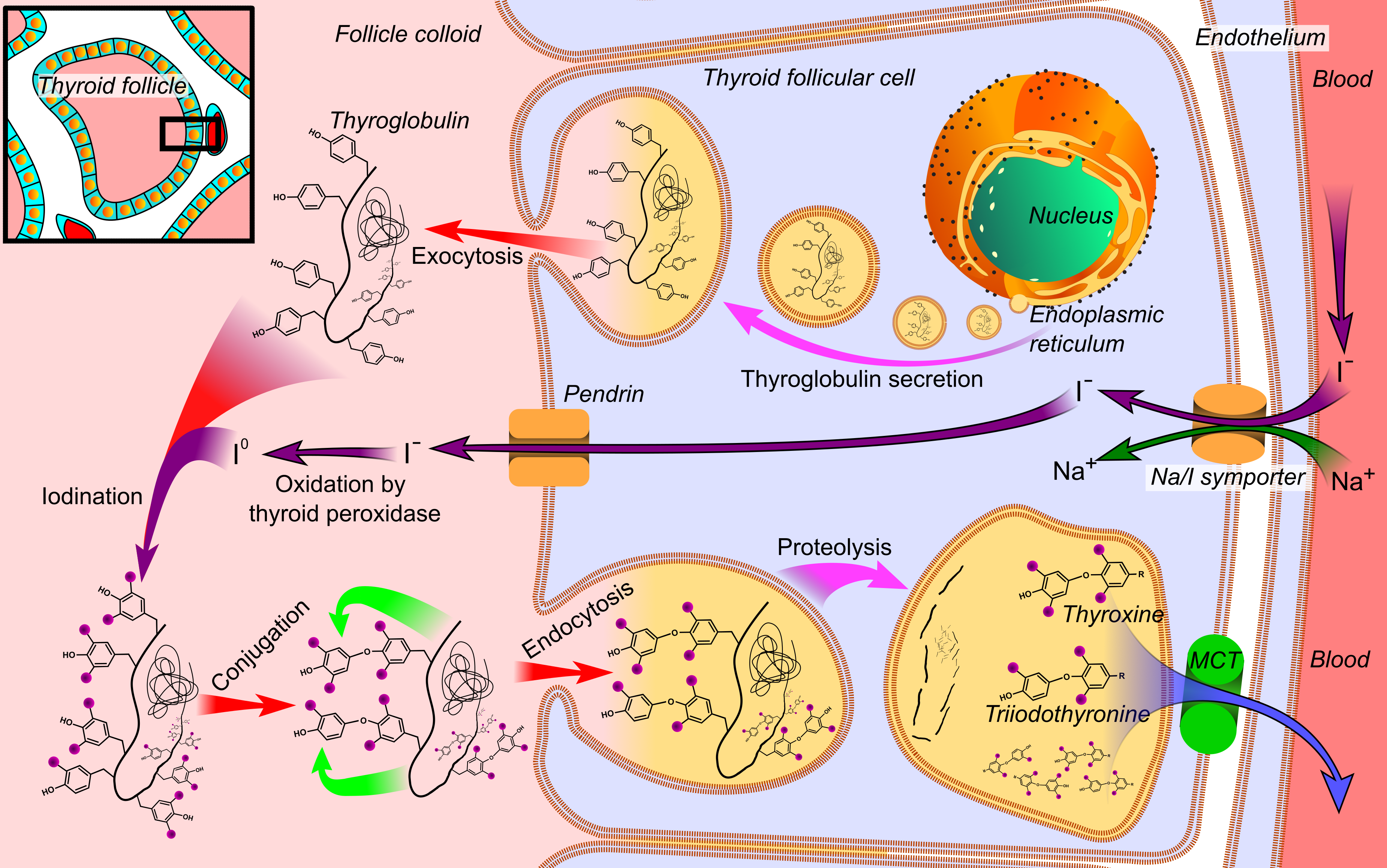|
Postpartum Thyroiditis
Postpartum thyroiditis is a type of thyroiditis, inflammation of the thyroid, occurring in the first 12 months after pregnancy and typically involves hyperthyroidism followed by hypothyroidism which is most often temporary. Postpartum thyroiditis is believed to result from the modifications to the immune system necessary in pregnancy, and histologically is the same as subacute lymphocytic thyroiditis also called silent thyroiditis or painless thyroiditis, a form of subacute thyroiditis. The process is normally self-limiting, but when thyroid antibodies are found there is a high chance of this proceeding to permanent hypothyroidism. Signs and symptoms The initial phase of hyperthyroid symptoms occurs transiently about two to six months postpartum. Typical symptoms include irritability, nervousness, palpitations, and heat intolerance. Hormonal disturbances during this phase tend to occur with lower intensity compared with the hypothyroid phase. As a result, the hyperthyroid phas ... [...More Info...] [...Related Items...] OR: [Wikipedia] [Google] [Baidu] |
Thyroiditis
Thyroiditis is the inflammation of the thyroid gland. The thyroid gland is located on the front of the neck below the laryngeal prominence, and makes hormones that control metabolism. Thyroiditis is a group of disorders that all cause thyroidal inflammation. Symptoms, diagnosis and treatment depend on the cause of thyroiditis. Forms of thyroiditis are Hashimoto's thyroiditis, postpartum thyroiditis, subacute (de Quervain's) thyroiditis, silent thyroiditis, drug-induced thyroiditis, radiation-induced thyroiditis and acute thyroiditis. Types Hashimoto's thyroiditis is an autoimmune disease where the body creates thyroid antibodies. It presents with hypothyroidism due to the destruction of thyroid cells. In Hashimoto's thyroiditis, the hypothyroidism is most often permanent, with symptoms are fatigue, weight gain, depression, dry skin, and constipation. Thyroid hormone replacement is the treatment of hypothyroidism. Silent thyroiditis or painless thyroiditis, also ... [...More Info...] [...Related Items...] OR: [Wikipedia] [Google] [Baidu] |
Postpartum Depression
Postpartum depression (PPD), also called perinatal depression, is a mood disorder which may be experienced by pregnant or postpartum women. Symptoms include extreme sadness, low energy, anxiety, crying episodes, irritability, and extreme changes in sleeping or eating patterns. PPD can also negatively affect the newborn child. The exact cause of PPD is unclear, however, it is believed to be due to a combination of physical, emotional, genetic, and social factors such as hormone imbalances and sleep deprivation. Risk factors include prior episodes of postpartum depression, bipolar disorder, a family history of depression, psychological stress, complications of childbirth, lack of support, or a drug use disorder. Diagnosis is based on a person's symptoms. While most women experience a brief period of worry or unhappiness after delivery, postpartum depression should be suspected when symptoms are severe and last over two weeks. Among those at risk, providing psychosocial su ... [...More Info...] [...Related Items...] OR: [Wikipedia] [Google] [Baidu] |
Type I Diabetes Mellitus
Type 1 diabetes (T1D), formerly known as juvenile diabetes, is an autoimmune disease that occurs when the body's immune system destroys pancreatic cells (beta cells). In healthy persons, beta cells produce insulin. Insulin is a hormone required by the body to store and convert blood sugar into energy. T1D results in high blood sugar levels in the body prior to treatment. Common symptoms include frequent urination, increased thirst, increased hunger, weight loss, and other complications. Additional symptoms may include blurry vision, tiredness, and slow wound healing (owing to impaired blood flow). While some cases take longer, symptoms usually appear within weeks or a few months. The cause of type 1 diabetes is not completely understood, but it is believed to involve a combination of genetic and environmental factors. The underlying mechanism involves an autoimmune destruction of the insulin-producing beta cells in the pancreas. Diabetes is diagnosed by testing the level of su ... [...More Info...] [...Related Items...] OR: [Wikipedia] [Google] [Baidu] |
Levothyroxine
Levothyroxine, also known as -thyroxine, is a synthetic form of the thyroid hormone thyroxine (T4). It is used to treat thyroid hormone deficiency (hypothyroidism), including a severe form known as myxedema coma. It may also be used to treat and prevent certain types of thyroid tumors. It is not indicated for weight loss. Levothyroxine is taken orally (by mouth) or given by intravenous injection. Levothyroxine has a half-life of 7.5 days when taken daily, so about six weeks is required for it to reach a steady level in the blood. Side effects from excessive doses include weight loss, trouble tolerating heat, sweating, anxiety, trouble sleeping, tremor, and fast heart rate. Use is not recommended in people who have had a recent heart attack. Use during pregnancy has been found to be safe. Dosing should be based on regular measurements of thyroid-stimulating hormone (TSH) and T4 levels in the blood. Much of the effect of levothyroxine is following its conversion to tri ... [...More Info...] [...Related Items...] OR: [Wikipedia] [Google] [Baidu] |
Beta-blockers
Beta blockers, also spelled β-blockers, are a class of medications that are predominantly used to manage abnormal heart rhythms (arrhythmia), and to protect the heart from a second heart attack after a first heart attack (secondary prevention). They are also widely used to treat high blood pressure, although they are no longer the first choice for initial treatment of most people. Beta blockers are competitive antagonists that block the receptor sites for the endogenous catecholamines epinephrine (adrenaline) and norepinephrine (noradrenaline) on adrenergic beta receptors, of the sympathetic nervous system, which mediates the fight-or-flight response. Beta-adrenergic receptors are found on cells of the heart muscles, smooth muscles, airways, arteries, kidneys, and other tissues that are part of the sympathetic nervous system and lead to stress responses, especially when they are stimulated by epinephrine (adrenaline). Beta blockers interfere with the binding to the receptor ... [...More Info...] [...Related Items...] OR: [Wikipedia] [Google] [Baidu] |
Graves' Disease
Graves' disease, also known as toxic diffuse goiter or Basedow's disease, is an autoimmune disease that affects the thyroid. It frequently results in and is the most common cause of hyperthyroidism. It also often results in an enlarged thyroid. Signs and symptoms of hyperthyroidism may include irritability, muscle weakness, sleeping problems, a fast heartbeat, poor tolerance of heat, diarrhea and unintentional weight loss. Other symptoms may include thickening of the skin on the shins, known as pretibial myxedema, and eye bulging, a condition caused by Graves' ophthalmopathy. About 25 to 30% of people with the condition develop eye problems. The exact cause of the disease is unclear, but symptoms are a result of antibodies binding to receptors on the thyroid causing over-expression of thyroid hormone. Persons are more likely to be affected if they have a family member with the disease. If one monozygotic twin is affected, a 30% chance exists that the other twin will ... [...More Info...] [...Related Items...] OR: [Wikipedia] [Google] [Baidu] |
Thyroid Stimulating Hormone
The thyroid, or thyroid gland, is an endocrine gland in vertebrates. In humans, it is a butterfly-shaped gland located in the neck below the Adam's apple. It consists of two connected lobes. The lower two thirds of the lobes are connected by a thin band of tissue called the isthmus (: isthmi). Microscopically, the functional unit of the thyroid gland is the spherical thyroid follicle, lined with follicular cells (thyrocytes), and occasional parafollicular cells that surround a lumen containing colloid. The thyroid gland secretes three hormones: the two thyroid hormones triiodothyronine (T3) and thyroxine (T4)and a peptide hormone, calcitonin. The thyroid hormones influence the metabolic rate and protein synthesis and growth and development in children. Calcitonin plays a role in calcium homeostasis. Secretion of the two thyroid hormones is regulated by thyroid-stimulating hormone (TSH), which is secreted from the anterior pituitary gland. TSH is regulated by thyro ... [...More Info...] [...Related Items...] OR: [Wikipedia] [Google] [Baidu] |
Hashimoto's Thyroiditis
Hashimoto's thyroiditis, also known as chronic lymphocytic thyroiditis, Hashimoto's disease and autoimmune thyroiditis, is an autoimmune disease in which the thyroid gland is gradually destroyed. Early on, symptoms may not be noticed. Over time, the thyroid may enlarge, forming a painless goiter. Most people eventually develop hypothyroidism with accompanying weight gain, fatigue, constipation, hair loss, and general pains. After many years the thyroid typically shrinks in size. Potential complications include thyroid lymphoma. Further complications of hypothyroidism can include high cholesterol, heart disease, heart failure, high blood pressure, myxedema, and potential problems in pregnancy. Hashimoto's thyroiditis is thought to be due to a combination of genetic and environmental factors. Risk factors include a family history of the condition and having another autoimmune disease. Diagnosis is confirmed with blood tests for TSH, thyroxine ( T4), antithyroid autoant ... [...More Info...] [...Related Items...] OR: [Wikipedia] [Google] [Baidu] |
Thyroid Peroxidase
Thyroid peroxidase, also called thyroperoxidase (TPO), thyroid specific peroxidase or iodide peroxidase, is an enzyme expressed mainly in the thyroid where it is secreted into colloid. Thyroid peroxidase oxidizes iodide ions to form iodine atoms for addition onto tyrosine residues on thyroglobulin for the production of thyroxine (T4) or triiodothyronine (T3), the thyroid hormones. In humans, thyroperoxidase is encoded by the ''TPO'' gene. Function Inorganic iodine enters the body primarily as iodide, I−. After entering the thyroid follicle (or thyroid follicular cell) via a Na+/I− symporter (NIS) on the basolateral side, iodide is shuttled across the apical membrane into the colloid via pendrin after which thyroid peroxidase oxidizes iodide to atomic iodine (I) or iodinium (I+). The chemical reactions catalyzed by thyroid peroxidase occur on the outer apical membrane surface and are mediated by hydrogen peroxide. The "organification of iodine", the incorporation of iodine ... [...More Info...] [...Related Items...] OR: [Wikipedia] [Google] [Baidu] |
Thyroglobulin
Thyroglobulin (Tg) is a 660 kDa, dimeric glycoprotein produced by the follicular cells of the thyroid and used entirely within the thyroid gland. Tg is secreted and accumulated at hundreds of grams per litre in the extracellular compartment of the thyroid follicles, accounting for approximately half of the protein content of the thyroid gland. Human TG (hTG) is a homodimer of subunits each containing 2768 amino acids as synthesized (a short signal peptide of 19 amino acids may be removed from the N-terminus in the mature protein). Thyroglobulin is in all vertebrates the main precursor to thyroid hormones, which are produced when thyroglobulin's tyrosine residues are combined with iodine and the protein is subsequently cleaved. Each thyroglobulin molecule contains approximately 16 tyrosine residues, but only around 10 of these are subject to iodination by thyroperoxidase in the follicular colloid. It takes two iodinated tyrosines to make a thyroid hormone molecule; therefor ... [...More Info...] [...Related Items...] OR: [Wikipedia] [Google] [Baidu] |
Euthyroid
The thyroid, or thyroid gland, is an endocrine gland in vertebrates. In humans, it is a butterfly-shaped gland located in the neck below the Adam's apple. It consists of two connected lobe (anatomy), lobes. The lower two thirds of the lobes are connected by a thin band of Connective tissue, tissue called the isthmus (: isthmi). Microscopically, the functional unit of the thyroid gland is the spherical Thyroid follicular cell#Location, thyroid follicle, lined with thyroid follicular cell, follicular cells (thyrocytes), and occasional parafollicular cells that surround a follicular lumen, lumen containing colloid. The thyroid gland secretes three hormones: the two thyroid hormonestriiodothyronine, triiodothyronine (T3) and thyroid hormone, thyroxine (T4)and a peptide hormone, calcitonin. The thyroid hormones influence the basal metabolic rate, metabolic rate and protein biosynthesis, protein synthesis and growth and development in children. Calcitonin plays a role in Calcium m ... [...More Info...] [...Related Items...] OR: [Wikipedia] [Google] [Baidu] |
Inflammation
Inflammation (from ) is part of the biological response of body tissues to harmful stimuli, such as pathogens, damaged cells, or irritants. The five cardinal signs are heat, pain, redness, swelling, and loss of function (Latin ''calor'', ''dolor'', ''rubor'', ''tumor'', and ''functio laesa''). Inflammation is a generic response, and therefore is considered a mechanism of innate immunity, whereas adaptive immunity is specific to each pathogen. Inflammation is a protective response involving immune cells, blood vessels, and molecular mediators. The function of inflammation is to eliminate the initial cause of cell injury, clear out damaged cells and tissues, and initiate tissue repair. Too little inflammation could lead to progressive tissue destruction by the harmful stimulus (e.g. bacteria) and compromise the survival of the organism. However inflammation can also have negative effects. Too much inflammation, in the form of chronic inflammation, is associated with variou ... [...More Info...] [...Related Items...] OR: [Wikipedia] [Google] [Baidu] |






